[English] 日本語
 Yorodumi
Yorodumi- EMDB-32287: Structure of USP14-bound human 26S proteasome in state EA2.1_UBL ... -
+ Open data
Open data
- Basic information
Basic information
| Entry |  | |||||||||
|---|---|---|---|---|---|---|---|---|---|---|
| Title | Structure of USP14-bound human 26S proteasome in state EA2.1_UBL with the local RPN1 density improved | |||||||||
 Map data Map data | Map of the human 26S proteasome in state EA2.1_UBL, with the RP/CP low-pass filtered to 3.8/2.8 angstrom and sharpened by a B-factor of -60/0, rescaled to the pixel size of 0.685 angstrom | |||||||||
 Sample Sample |
| |||||||||
 Keywords Keywords | Proteasome / AAA-ATPase / Deubiquitinase / USP14 / HYDROLASE | |||||||||
| Biological species |  Homo sapiens (human) Homo sapiens (human) | |||||||||
| Method | single particle reconstruction / cryo EM / Resolution: 3.3 Å | |||||||||
 Authors Authors | Zhang S / Zou S / Yin D / Wu Z / Mao Y | |||||||||
| Funding support |  China, 1 items China, 1 items
| |||||||||
 Citation Citation |  Journal: Nature / Year: 2022 Journal: Nature / Year: 2022Title: USP14-regulated allostery of the human proteasome by time-resolved cryo-EM. Authors: Shuwen Zhang / Shitao Zou / Deyao Yin / Lihong Zhao / Daniel Finley / Zhaolong Wu / Youdong Mao /   Abstract: Proteasomal degradation of ubiquitylated proteins is tightly regulated at multiple levels. A primary regulatory checkpoint is the removal of ubiquitin chains from substrates by the deubiquitylating ...Proteasomal degradation of ubiquitylated proteins is tightly regulated at multiple levels. A primary regulatory checkpoint is the removal of ubiquitin chains from substrates by the deubiquitylating enzyme ubiquitin-specific protease 14 (USP14), which reversibly binds the proteasome and confers the ability to edit and reject substrates. How USP14 is activated and regulates proteasome function remain unknown. Here we present high-resolution cryo-electron microscopy structures of human USP14 in complex with the 26S proteasome in 13 distinct conformational states captured during degradation of polyubiquitylated proteins. Time-resolved cryo-electron microscopy analysis of the conformational continuum revealed two parallel pathways of proteasome state transitions induced by USP14, and captured transient conversion of substrate-engaged intermediates into substrate-inhibited intermediates. On the substrate-engaged pathway, ubiquitin-dependent activation of USP14 allosterically reprograms the conformational landscape of the AAA-ATPase motor and stimulates opening of the core particle gate, enabling observation of a near-complete cycle of asymmetric ATP hydrolysis around the ATPase ring during processive substrate unfolding. Dynamic USP14-ATPase interactions decouple the ATPase activity from RPN11-catalysed deubiquitylation and kinetically introduce three regulatory checkpoints on the proteasome, at the steps of ubiquitin recognition, substrate translocation initiation and ubiquitin chain recycling. These findings provide insights into the complete functional cycle of the USP14-regulated proteasome and establish mechanistic foundations for the discovery of USP14-targeted therapies. | |||||||||
| History |
|
- Structure visualization
Structure visualization
| Supplemental images |
|---|
- Downloads & links
Downloads & links
-EMDB archive
| Map data |  emd_32287.map.gz emd_32287.map.gz | 933.4 MB |  EMDB map data format EMDB map data format | |
|---|---|---|---|---|
| Header (meta data) |  emd-32287-v30.xml emd-32287-v30.xml emd-32287.xml emd-32287.xml | 15.1 KB 15.1 KB | Display Display |  EMDB header EMDB header |
| Images |  emd_32287.png emd_32287.png | 102.9 KB | ||
| Filedesc metadata |  emd-32287.cif.gz emd-32287.cif.gz | 4.1 KB | ||
| Others |  emd_32287_additional_1.map.gz emd_32287_additional_1.map.gz | 59 MB | ||
| Archive directory |  http://ftp.pdbj.org/pub/emdb/structures/EMD-32287 http://ftp.pdbj.org/pub/emdb/structures/EMD-32287 ftp://ftp.pdbj.org/pub/emdb/structures/EMD-32287 ftp://ftp.pdbj.org/pub/emdb/structures/EMD-32287 | HTTPS FTP |
-Validation report
| Summary document |  emd_32287_validation.pdf.gz emd_32287_validation.pdf.gz | 568.4 KB | Display |  EMDB validaton report EMDB validaton report |
|---|---|---|---|---|
| Full document |  emd_32287_full_validation.pdf.gz emd_32287_full_validation.pdf.gz | 568 KB | Display | |
| Data in XML |  emd_32287_validation.xml.gz emd_32287_validation.xml.gz | 8.6 KB | Display | |
| Data in CIF |  emd_32287_validation.cif.gz emd_32287_validation.cif.gz | 9.9 KB | Display | |
| Arichive directory |  https://ftp.pdbj.org/pub/emdb/validation_reports/EMD-32287 https://ftp.pdbj.org/pub/emdb/validation_reports/EMD-32287 ftp://ftp.pdbj.org/pub/emdb/validation_reports/EMD-32287 ftp://ftp.pdbj.org/pub/emdb/validation_reports/EMD-32287 | HTTPS FTP |
-Related structure data
| Related structure data | 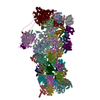 7w37C  7w38C 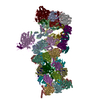 7w39C 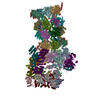 7w3aC  7w3bC 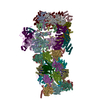 7w3cC 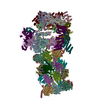 7w3fC 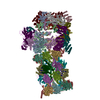 7w3gC 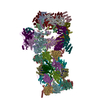 7w3hC 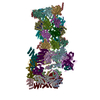 7w3iC 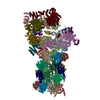 7w3jC 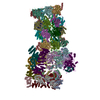 7w3kC 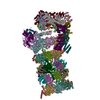 7w3mC C: citing same article ( |
|---|
- Links
Links
| EMDB pages |  EMDB (EBI/PDBe) / EMDB (EBI/PDBe) /  EMDataResource EMDataResource |
|---|
- Map
Map
| File |  Download / File: emd_32287.map.gz / Format: CCP4 / Size: 1000 MB / Type: IMAGE STORED AS FLOATING POINT NUMBER (4 BYTES) Download / File: emd_32287.map.gz / Format: CCP4 / Size: 1000 MB / Type: IMAGE STORED AS FLOATING POINT NUMBER (4 BYTES) | ||||||||||||||||||||||||||||||||||||
|---|---|---|---|---|---|---|---|---|---|---|---|---|---|---|---|---|---|---|---|---|---|---|---|---|---|---|---|---|---|---|---|---|---|---|---|---|---|
| Annotation | Map of the human 26S proteasome in state EA2.1_UBL, with the RP/CP low-pass filtered to 3.8/2.8 angstrom and sharpened by a B-factor of -60/0, rescaled to the pixel size of 0.685 angstrom | ||||||||||||||||||||||||||||||||||||
| Projections & slices | Image control
Images are generated by Spider. | ||||||||||||||||||||||||||||||||||||
| Voxel size | X=Y=Z: 0.685 Å | ||||||||||||||||||||||||||||||||||||
| Density |
| ||||||||||||||||||||||||||||||||||||
| Symmetry | Space group: 1 | ||||||||||||||||||||||||||||||||||||
| Details | EMDB XML:
|
-Supplemental data
-Additional map: Unfiltered, unsharpened map of the human 26S proteasome...
| File | emd_32287_additional_1.map | ||||||||||||
|---|---|---|---|---|---|---|---|---|---|---|---|---|---|
| Annotation | Unfiltered, unsharpened map of the human 26S proteasome in state EA2.1_UBL | ||||||||||||
| Projections & Slices |
| ||||||||||||
| Density Histograms |
- Sample components
Sample components
-Entire : 26S proteasome
| Entire | Name: 26S proteasome |
|---|---|
| Components |
|
-Supramolecule #1: 26S proteasome
| Supramolecule | Name: 26S proteasome / type: complex / ID: 1 / Parent: 0 / Macromolecule list: #1-#33 |
|---|---|
| Source (natural) | Organism:  Homo sapiens (human) Homo sapiens (human) |
| Molecular weight | Theoretical: 2.5 MDa |
-Experimental details
-Structure determination
| Method | cryo EM |
|---|---|
 Processing Processing | single particle reconstruction |
| Aggregation state | particle |
- Sample preparation
Sample preparation
| Buffer | pH: 7 |
|---|---|
| Vitrification | Cryogen name: ETHANE |
- Electron microscopy
Electron microscopy
| Microscope | FEI TITAN KRIOS |
|---|---|
| Image recording | Film or detector model: GATAN K2 SUMMIT (4k x 4k) / Average electron dose: 50.0 e/Å2 |
| Electron beam | Acceleration voltage: 300 kV / Electron source:  FIELD EMISSION GUN FIELD EMISSION GUN |
| Electron optics | Illumination mode: FLOOD BEAM / Imaging mode: BRIGHT FIELD / Nominal defocus max: 5.0 µm / Nominal defocus min: 0.4 µm |
| Experimental equipment |  Model: Titan Krios / Image courtesy: FEI Company |
- Image processing
Image processing
| Startup model | Type of model: EMDB MAP EMDB ID: |
|---|---|
| Final reconstruction | Resolution.type: BY AUTHOR / Resolution: 3.3 Å / Resolution method: FSC 0.143 CUT-OFF / Number images used: 61930 |
| Initial angle assignment | Type: MAXIMUM LIKELIHOOD |
| Final angle assignment | Type: MAXIMUM LIKELIHOOD |
 Movie
Movie Controller
Controller


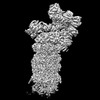




















 Z (Sec.)
Z (Sec.) Y (Row.)
Y (Row.) X (Col.)
X (Col.)





























